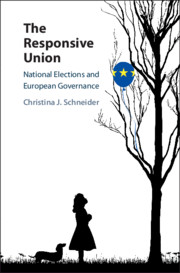Book contents
- Frontmatter
- Dedication
- Contents
- List of Figures
- List of Tables
- Acronyms
- Acknowledgements
- 1 Responsive Governance in the European Union
- 2 The Politicization of European Cooperation
- 3 Signals of Responsiveness: A Theory
- 4 The EU-Aware Voter
- 5 The EU Budget: Financially Trivial, Politically Substantial
- 6 Triumph and Agony in the 2007–2013 MFF Negotiations
- 7 The Legislative Leviathan Marionette
- 8 The Waiting Game: Après les élections, le déluge
- 9 When the Music Stops: The German Politics of the Greek Bailout
- 10 The European Republic
- References
- Index
3 - Signals of Responsiveness: A Theory
Published online by Cambridge University Press: 29 October 2018
- Frontmatter
- Dedication
- Contents
- List of Figures
- List of Tables
- Acronyms
- Acknowledgements
- 1 Responsive Governance in the European Union
- 2 The Politicization of European Cooperation
- 3 Signals of Responsiveness: A Theory
- 4 The EU-Aware Voter
- 5 The EU Budget: Financially Trivial, Politically Substantial
- 6 Triumph and Agony in the 2007–2013 MFF Negotiations
- 7 The Legislative Leviathan Marionette
- 8 The Waiting Game: Après les élections, le déluge
- 9 When the Music Stops: The German Politics of the Greek Bailout
- 10 The European Republic
- References
- Index
Summary
The chapter develops the main theoretical argument about signals of responsive governance in the European Union. My definition of political responsiveness draws from typical definitions of responsiveness in democratic systems, and is adapted to fit the European context. To take into account signals of responsiveness at different stages in European cooperation, I focus on the willingness and ability of EU governments to signal both input and output responsiveness in EU negotiations. Governments want to signal to their electorate that they take positions that are in the constituents' interests, and defend these positions throughout the negotiation process. They also want to achieve negotiation outcomes that are favorable for their constituents. But even though all governments would like to appear responsive, not all governments are equally competent at achieving this goal because they have to navigate the collective decision-making system of the EU. To signal responsiveness, governments either use their formal and informal bargaining leverage or they seek reciprocal agreements with their EU counterparts.
Keywords
- Type
- Chapter
- Information
- The Responsive UnionNational Elections and European Governance, pp. 42 - 71Publisher: Cambridge University PressPrint publication year: 2018



